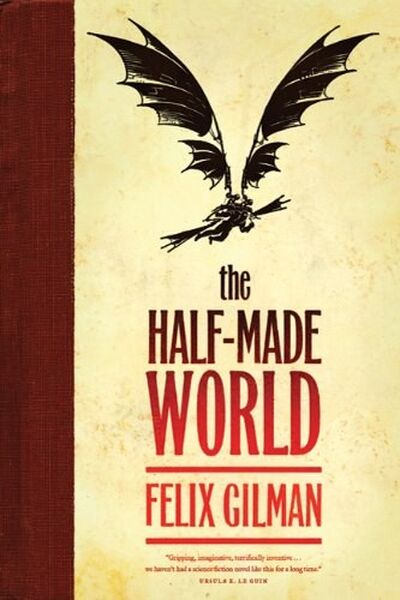Between the Millstones
The Half-Made World (Half-Made World, volume 1)
By Felix Gilman

17 Feb, 2016
0 comments
Felix Gilman’s 2010 novel The Half-Made World takes us to a continent whose westernmost expanses are still forming out of primordial chaos. Demons and worse lurk there. Two monstrous factions struggle for control of the new frontier: the Gun, a cabal of possessed warriors doling out violence and cruelty on a retail scale, and the Line, a horrific railway that serves up terror and oppression wholesale.
Here and there are pockets of free people, but their freedom is doomed. Despite the Gun’s best efforts, the Line is inexorably consuming the whole of the continent. Victory seems assured.
At least, it does until a rumour begins to circulate.
The Red Republic was crushed decades ago, its people scattered, its heroes slain. All but one: the General was terribly wounded but he survived, his mind shattered, as just another broken patient in a mental institution. Before he was struck down, the General learned of a weapon so terrible that even demons must fear it. As long as the General lives, there is a chance he might somehow remember and share what he discovered.
This rumour prompts Gun to dispatch gunslinger Creedmore to seek out the General. He is to seize the weapon, whatever it is, for the Gun; if that isn’t possible, he is to silence the General forever. But the Line has also heard the rumour; their agent Lowry may be a mere functionary but he is backed up with an army of faceless men, all armed with terrible weapons.
The General’s only protection is doctor Liv Alverhyusen; she refuses to simply abandon a patient, but she is seemingly powerless to alter the crisis into which bad timing and bad luck have thrown her.
~oOo~
The Old West! In many ways central to the American image of itself but also kind of problematic. Free land for settlers requires that the people already living there be … displaced. Displaced sounds neutral enough, right? Just another brightly coloured tile in the glorious mosaic of human history. Everyone does it. One population displaces another with the aid of better weapons (iron, horses, chariots, cannon, guns, etc.) and in some cases, epidemic disease. It’s just as if I were to mug you for the wallet which is inexplicably in your possession — inexplicably because I am clearly entitled to that wallet, as I am religiously, morally, genetically, and/or technologically superior1.
Strangely enough, a great many speculative fiction authors have been troubled by this aspect of American history and have produced a rich body of work dedicated to scuffing dirt over the ugliness.
One tack is to re-imagine the Old West. Erase the natives entirely, allowing the author to enjoy a Little House on the Prairie2 in a land where unpleasant issues like “whatever happened to the people who used to live here?” never arise3.
Gilman takes a different tack, imagining a fantasy realm inspired by certain elements of Old West folklore. Rather than being unsettled (for values of “by white people” of unsettled), the western expanses are literally still forming; a new frontier indeed! Some authors imagine American natives as more in touch with nature than Europeans; Gilman dials that up to eleven, with his inhumanly pale Folk (who resemble a species of technologically backward elves). The forces driving the conflict are literally inhuman and the humans are their pawns.
Rather like its setting, the book is clearly realized on one edge (the beginning of the book) and vague on the other (the ending). The half-formed world, the conflict between Gun and Line, the demons, the characters: all are limned in firm, clear strokes. But the closer one approaches the novel’s conclusion, the vaguer things become. Do not head for the westernmost shore expecting a clearly delineated coast and do not read to the end of this book expecting a satisfying conclusion.
I initially assumed that the indecisive ending was a mere cliff-hanger, a hook for future volumes. A bit of poking around suggests the next novel Gilman wrote, The Rise of Ransom City, is not a direct sequel, although it is set in the same world.
I think I will put this firmly into the “not my thing” box. However, people looking for a China-Mieville-style Weird Western might enjoy this. The Half-Made World is available from Tor.
- Oh, sure: it is upsetting to you now, but in a few centuries it will be old history. Why privilege an immediate reaction over a more considered, long-term view? Please stop screaming.
- TV show, not the books.
- It can be surprisingly difficult to imagine an alternate world without those inconvenient natives where the knock-on effects of the method used to keep them from existing don’t have secondary effects the author does not intend. For example, if we imagine a magical barrier that keeps Old World humans out and the species native to North America in, say goodbye to horses in the Old World. For that matter, there may not be any hominids to evolve into humans.…
